News
The Black Experience in Graphic Design: 1968 and 2020
We asked 15 design leaders to look back at Print’s report on racism in the profession. What has changed? What remains the same?

Just over fifty years ago, at the apex of the civil rights movement in the US, Dorothy Jackson interviewed five Black designers about “the frustrations and opportunities in a field where ‘flesh-colored’ means pink”. The article for Print was perhaps the first in the mainstream trade press to directly address the impacts of racism in the profession and describe the experience of Black practitioners in their own words. What has changed since then? What remains the same? We asked today’s design leaders to compare their experience to the 1968 discussion and imagine what’s next.
The Black Experience in Graphic Design, 1968
These images are high-resolution and zoomable for reading. Republished with permission from Print.
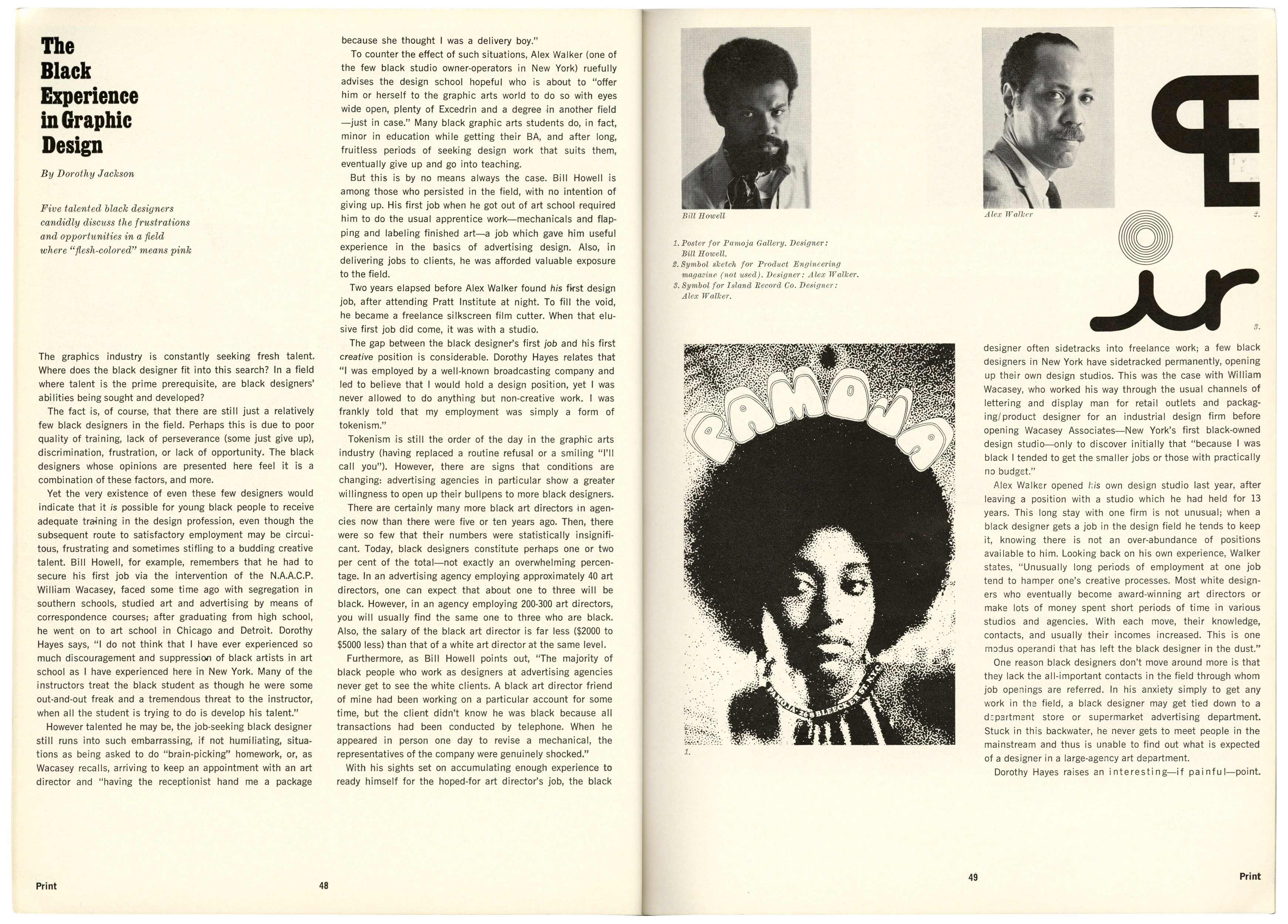

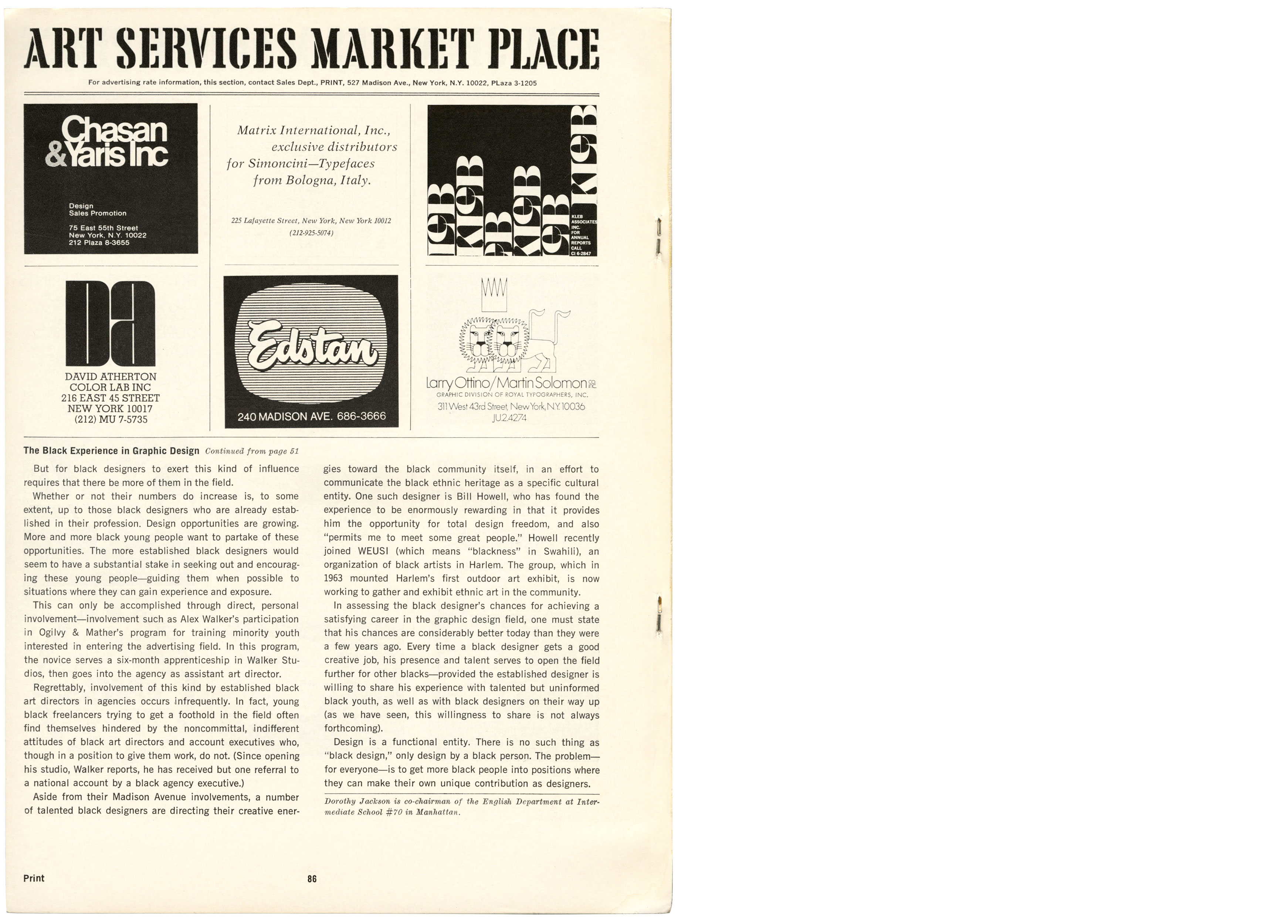
The Black Experience in Graphic Design, 2020
Bobby C. Martin Jr.

What in the article resonated most for you?
It is hard to believe that this article was written in 1968. More than 50 years later, very little has changed. According to the 2019 design census created by AIGA and Google, Black men and women make up just 3% of the design industry. We are 13% of the total US population. The failure to close that gap is a failure of our educational institutions, our industry organizations, and the design profession as a whole.
Better representation means better communication, which means information is more equitably shared — and knowledge is power.
Why does it matter? Graphic design is about communication. It is about access to information. To get more information to more people, we need more understanding. We need the communicators, the designers, to better represent the people they’re talking to. Better representation means better communication, which means information is more equitably shared — and knowledge is power. The makeup of our industry needs to better reflect the makeup of our country.
To break the cycle, we need a more diverse mix of industry gatekeepers. We need design writers to seek out more inclusive stories — and to help rewrite history. We need awards shows to open up entries, open up judging, and celebrate craft in all its many permutations. And we need the people that do the hiring to do the work of seeking out representation at every level of design. The trick is that it’s going to be a lot of work. It’s worth it.
Many of the jobs promoting Black culture were awarded to White designers.
What has changed?
It would be reasonable to expect that the work of all these featured designers be documented and shared in our design history books, but I had never heard of them until the article was reprinted in June. None of the names show up in a Google search. It’s no wonder that young Black design students, like me, thought Reid Miles, James Victore, Randy Balsmeyer, and Milton Glaser were Black. Before Google, before I made my way to New York City, I assumed that the most iconic work made for Black music, film, and culture was made by Black designers. It turns out that not only was design history blind to Black designers, but the industry was too. Many, not all, but many of the jobs promoting Black culture were awarded to White designers. Now I’m left to wonder how many of the recent ads showing support for the Black Lives Matter movement were created by Black designers or Black-owned agencies? And, if the work is Black-made, will it make it into our history books?
Do you see signs of future change?
I remain hopeful. Young designers are calling out an industry stuck in its old ways. Black designers are holding doors open and pulling up. There are more Black business owners and more Black marketing executives taking their seat at the table. Design cannot ignore the national mandate for change. We’re marching in the streets. It’s time to embrace the reckoning and see what’s on the other side.
Eddie Opara

What in the article resonated most for you?
The ongoing difficulties, the psychological trauma of always feeling as though you are being tied down and constantly suppressed by teachers, colleagues, clients, and the media, yet still have the will to succeed. At the time of the article’s publication, 1% to 2% of designers were Black. In a 2011 New York Times article, “Design Gets More Diverse”, I stated, “There are more Black designers coming up now. … But it is disappointing that there aren’t more of us.” Now there is approximately 3%. When you look at leadership those numbers dwindle even more. This is truly devastating. It begs the question, “Is the term tokenism more exacting now than before?”
What has changed?
50 years have passed, and a miserly 1% of change should answer the crux of the question. Only now has awareness of this systemic issue been seriously identified, caused by the recent social justice upheaval. But how long is this going to last? Black unemployment has historically risen over those 50 years. Even when, in the US, 73% of the White population believe that mainstream culture is strongly Black influenced, and $1.3 trillion per year is spent by Black consumers, the piece of the pie is severely skewed. There have been sporadic diversity and inclusion initiatives within the design field, to expose and deal with these stigmatic matters, but alas, they quickly run cold, dying out, only to resurface when another distressing event occurs.
What remains the same?
The systemic social and economic differences for the Black population within the Western world is abhorrent, let alone in the rest of world. This situation should be considered a disease — a condition that has been an affliction upon the Black population for hundreds of years, that doesn’t disappear overnight. Although technology has helped us all to be more informed, when there is a plethora of subject matter connected to design, on a race level, the accessibility to good technology and education has been lacking.
Being Black, there is a propensity to retain a sense of hope, but maybe that’s what the White population is wishing: keep the hope alive, but never make it to the table.
Do you see signs of future change?
It’s too early to know whether this is a sign of the industry’s tokenism, hollow words, lip service, insincerity — call it what you will — we shall see. One has to be hopeful. Being Black, there is a propensity to retain a sense of hope, but maybe that’s what the White population is wishing: keep the hope alive, but never make it to the table. A threaded approach is required. This cannot be a reckless, staccato enterprise — one that only works at a single stage through the life of the Black designer. It requires a strategy that sows itself through and loops back: starting with good knowledge about what design is, what it can do and be for a fledgling Black creative, their parents/guardians, and communities; second, a good education that’s not expensive, or at an elite school, that allows them to be taught by Black teachers within a diverse academic setting, and that Black designers are represented in the annals of design history; thirdly, good jobs through to good leadership, by means of excellent mentoring programs, spanning the course of a Black designer’s career.
Forest Young

What in the article resonated most for you?
Alex Walker’s words from 1968 are haunting. He states that “most White designers who eventually become award-winning art directors or make lots of money spent short periods of time in various studios and agencies.” In short, the pathway to creating generational wealth is to have a successful “revolving door” career. With each successive jump, the professional designer is able to dramatically alter her salary trajectory, her exposure to new areas of practice, and broaden the reach and potency of her network. The gatekeeper friction working against BIPOC designers has catastrophic implications for the distribution of wealth. The token hires are ultimately self-serving to White employers, but ignore the best interests of their employees.
What has changed?
Today, the requirements to be a viable graphic design practitioner are: a phone, a laptop, and access to design software. The world of 1968 required considerably more initial capital to run a successful business — office real estate, promotional stationery, and studio equipment.
The internet — as a medium for exposure and discovery of BIPOC design work — represents another great mechanism to help even the playing field. While the client boardroom participants remain strikingly similar to 1968, it is much harder for White practitioners to take credit for the work of BIPOC designers given the transparency and speed of digital networks.
What remains the same?
Because graphic design, unlike architecture, lacks a licensing requirement, it is a profession dominated by networking and word-of-mouth referrals, and is thus particularly vulnerable to the compounding effects of “cultural fit”. Cultural fit, and its subsequent homogeneity, has become code for hermetically sealed White social contexts: parental networks, undergraduate fraternities and sororities, and art school alumni networks.
“Cultural fit”, and its subsequent homogeneity, has become code for hermetically sealed White social contexts.
Peripheral entities like headhunters often play into these pre-existing cultural norms and represent candidates that have a greater placement potential, resulting in more consistent commissions. Educators are not incentivized to revise Eurocentric pedagogy and tunnel-visioned history due to tenure, elevated stature within the profession, and the successful professional placement of star students that validate the norm.
Do you see signs of future change?
Noticeable efforts to decolonize design education — from inspired teachers like Dori Tunstall at OCAD and Ramon Tejada at RISD, are affirming long overdue pedagogical shifts at top-tier programs. Nikole Hannah-Jones, the Pulitzer Prize-winning creator of the landmark 1619 Project, is providing adjacent pressure to reimagine calcified histories.
Employers are now doubling down on premier art schools as a trusted filtering mechanism, further intensifying the exclusionary effect of top-tier access.
Though the great volume of BIPOC designers seeking to enter the profession is at-once reassuring, it also creates a cascading effect — with a higher influx of potential candidates, employers are now doubling-down on premier art schools as a trusted filtering mechanism, further intensifying the exclusionary effect of top-tier access. The inertia of tokenism remains un-braked, as optical diversity is much more palatable than a sincere, systemic overhaul.
Franc Nunoo-Quarcoo

What in the article resonated most for you?
It’s as if time, perception, and attitudes have changed very little in 52 years. 1968 promised access, equality, inclusion, diversity, and a shift in how we live and relate as Americans. This year, 2020, opened with a reckoning of a stasis in the process for “progress”. The climate, as reported then and now, is only slightly warmer in temperature. Certainly, there have been some changes that allow for someone like me to express my informed opinions. Then and now, design is still dependent on inflexible corporate, cultural, and institutional environments. Dorothy Jackson’s article uncovers familiar observations I explore with students, colleagues, and administrators. What particularly resonates with me is that inexplicably, “The more things change, the more they stay the same.” Perhaps the 19th-century critic Jean-Baptiste Alphonse Karr had a clear insight into the 20th and 21st centuries.
1968 was a year of upheaval and a referendum on change and progress. Then, young adults captured the imagination of the world and articulated real change — accountability for all Americans. Graphic design was still a nascent profession in dire need of definition. In 2020, tools of the profession have been revolutionized. Academic institutions must be more inclusive. Instructors and curricula are in transition. The relevant histories in journals, books, films, and archives must account for diversity and inclusion. Recently, the AIGA announced the appointment of Bennie F. Johnson as Executive Director. That move also signals a continuum of change.
In 2020, tools of the profession have been revolutionized. Academic institutions must be more inclusive. Instructors and curricula are in transition. The relevant histories in journals, books, films, and archives must account for diversity and inclusion.
What could happen if the College Art Association (CAA) and AIGA shared joint activities for mutual benefit? The organizations share similar evolutions and aspirations. What could happen if these two organizations collectively addressed diversity, equity, inclusion, ethics in the workplace and the marketplace? Better still, what could it mean if the AIGA, CAA, the Society for Environmental Graphic Design (SEGD), and the American Institute of Architects worked to address issues and aspirations as cross-disciplinary organizations? These silos must overlap to work on the many vexing issues that have existed since their respective formations in the 19th and 20th centuries.
Do you see signs of future change?
Access to good design must be a fundamental and universal right. Design must be a valued and relevant agent in a changing world. The evolving events in the first half of 2020 could signify a better future if we adopt the following:
- Foster a growing population of diverse, culturally competent, justly compensated, resilient, and knowledge-based design professionals.
- Redefine perceptions of the design profession by broadly disseminating effective models of education, ethics, collaboration, entrepreneurship, and philanthropy.
- Substantiate the critical role communication designers play in collaboration with allied disciplines in advancing solutions that directly impact cultural, social, economic, and environmental challenges. In the article, Jackson presciently notes, “Design is a functional entity. There is no such thing as ‘Black design’, only design by a Black person. The problem for everyone is to get more Black people into positions where they can make their own unique contribution as designers.”
Gail Anderson
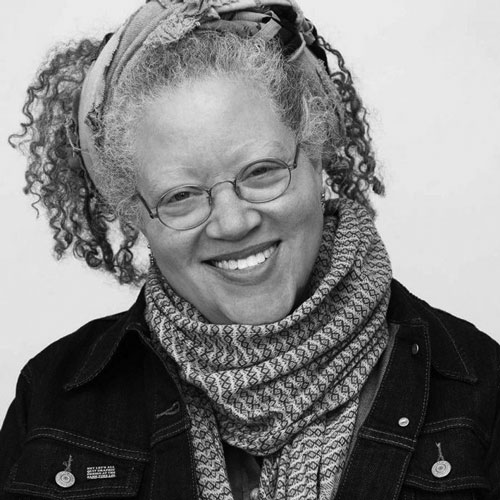
What in the article resonated most for you?
I shuddered with recognition at William Wacasey’s story of being mistaken for a messenger. I had a similar experience back in the mid-1980s as a young designer at The Boston Globe, and was rendered speechless at the front desk of the company I’d worked for for at least a year at the time. The article brought up a host of feelings, of course, but it jogged my memory about one of my first truly eye-rolling professional experiences (or SMH as the kids say).
The current climate is simultaneously horrifying and inspiring.
What has changed? What remains the same?
Do people still make assumptions or ask my opinion because, “Well, you know…”? Yes, they do, and I’ve learned to roll with it, like most BIPOC. I take a deep breath and hope that I’ve helped to move things forward just a little for the next generation, and that they’ll do the same for the one that follows. The current climate is simultaneously horrifying and inspiring because there’s a glimmer of hope for real change at such a divisive moment in history.
Do you see signs of future change?
Right now, there’s a lot of anger in the industry, but with that comes awareness followed by change. There are people who realize they’ve had their head in the sand for too long, and who are choosing to examine the way they do business. I do see change on the horizon, but it has to be more than a bandaid, or people will move on to whatever social media demands. Our ongoing battle is so much more than that — so much more than a black box on Instagram or an angry tweet (or even one of solidarity). I have faith that our industry will rise to the occasion and become even stronger and better. But lasting change takes time, and I hope we can all remain focused on the difficult and sometimes painful examination and efforts involved.
I do see change on the horizon, but it has to be more than a bandaid. Our ongoing battle is so much more than a black box on Instagram or an angry tweet.
Gil Ashby

What in the article resonated most for you?
The ratio factor of Black visibility within most design workspaces at most institutions across the world remains high. Lack of diversity serves not only as a discouraging optic; it hinders a work environment of emotional security, something which is essential to creative freedom.
Lack of diversity serves not only as a discouraging optic; it hinders a work environment of emotional security, something which is essential to creative freedom.
What has changed?
The awareness of those who broke through “the glass ceiling” brings hope. There is now an axiom that, with proper training and mentorship, Black creatives can forge paths and possibly surpass expectations. The system of impediments is now commonly understood, and it has engendered a willingness to fight and educate, to navigate and overcome.
Manifest possibilities fostered by LBJ’s “Great Society”, and brought about by the forces of the movement — King, Rustin, Malcolm, Angelou, Angela (Davis), Ali, Ellington, Miles, and untold soldiers just out of sight — gave Black folk from my generation the temerity to believe.
In 1999, three decades after the article, I was hired to chair the Illustration program at the College for Creative Studies in Detroit. At the time I was the only Black art professional in the country to lead an illustration department in an ACAD college. As with Bill Howell, I understood the optics of a Black creative soul in a position of authority, perceived or real, who gets to pass those tokens for others to ride the train. Any opportunity to pay forward as an advocate and mentor is vital in advancing change in our social system.
From the time I started college in 1976, to the completion of my degrees in 1986, the ratio of Blacks to Whites remained one to 20.
What remains the same?
The ratio of Black to White in positions of power has barely changed. From the time I started college in 1976, to the completion of my BFA and MFA degrees in 1986, the ratio of Blacks to Whites (from the classroom to the boardroom) remained one to 20. Representation has an immediate impact when one walks into the room. The sense of possibilities based on the mix we see — or do not — instills a first impression that will catapult a soul to the next levels up or reinforce the limiting norm!
Do you see signs of future change?
Handheld devices spread information to the masses! We are witnessing the power of tech to communicate to a sophisticated audience that never before existed. And yes! The revolution is now televised!
Like the voices we find on the internet, in film, and in comics, the design world requires a diversity of creatives to represent this global community, to shed light on the historic mechanizations “hidden in plain sight” that perpetuate the notion that the color of flesh is pink.
We require a plurality of taste and style to tell our stories and swing the pendulum in favor of the long arc of the universe as it bends towards justice.
Jennifer White-Johnson
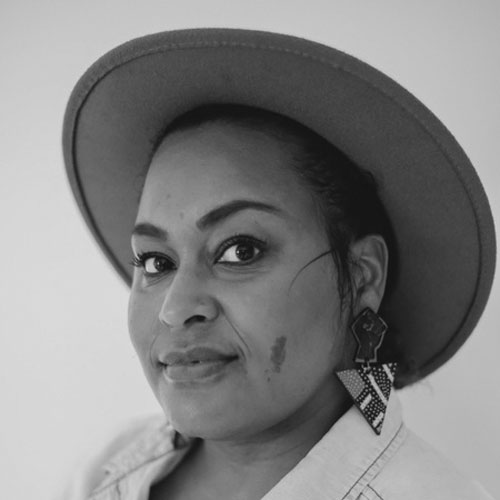
What in the article resonated most for you?
All of it. I felt like I was reading an article that could’ve been written in 2020. Having spent the past 10 years teaching design students at an HBCU [Historically Black College or University], I’ve gained a lot of perspective that I feel some “top tier” schools miss when it comes to the amplification and empowerment of Black students. I’m directly connected to the future of design the moment a student declares their major. I often tell my students that advertising is more than just designing a useful product, but how can that product or system shift the culture that often appropriates or oppresses Black futures?
The article touches on training programs for young Black designers and their direct personal involvement when it states, “A number of talented Black designers are directing their creative energies toward the Black community itself in an effort to communicate the Black ethnic heritage as a specific cultural entity”, and as Bill Howell said, “Total design freedom permits me to meet some great people.” This is where I have seen a lot of young Black designers thrive, as it’s real, raw, and authentic to the community they are asked to serve.
I was happy to read about the radical Black community of the 1960s. For instance, the reference to the WEUSI design collective was beautiful. And Harlem’s first outdoor art exhibit is reminiscent of many programs that HBCUs and the Black community organize to amplify their community. I respect the work of Antionette Carroll and Creative Reaction Lab for this reason; the Black community and Black futures are at the forefront of their work and practice. As my disabled writer and friend Alice Wong says, “Culture Work is Political Work”, and I continue to see this reflected in what young Black designers of my generation are already doing! Hadiya Williams does this with sculptural forms; Jermaine T. Bell does this with collage and digital Illustration; Dian Holton does this with art direction; Maurice Cherry does this with Revision Path; Kojo Boateng does this with preserving cultural communities; Andrea Pippins does this with illustration and visual narratives; and Denise Shante Brown does this by challenging the way Black womxn can design systems of transformation and restoration.
As my disabled writer and friend Alice Wong says, “Culture Work is Political Work”, and I continue to see this reflected in what young Black designers of my generation are already doing!
What has changed?
At Bowie State we like to think of our students as visual cultural producers. This is evident when the majority of my BIPOC students’ senior thesis projects examine the topic of equitable cultural representation in advertising. Many of my students think very editorially, and they are amped to curate their own content when given the opportunity. The article states, “Black people are an integral part of the American social and economic scene — on all levels.” We see this in 2020, in a class of 15–20 students, when about five of them have already started their own YouTube channels covering various narratives on race and culture. They are already owning their content in dynamic ways. To me, that’s a valid way of encouraging them to learn more about their craft. Their stories should continue to evolve throughout their design education. It’s my role to hold space for that. I’ve seen grad students from other art programs use their education as their opportunity to reclaim and define their personal narrative.
What remains the same?
The article also states, “The advertising industry is geared almost exclusively to White attitudes and standards, White concepts of beauty, White modes of fashion. … Black designers … must push for a positive view of Blacks in advertising, as well as for their appearance in advertising in proportion to their buying power.” This continues to be true as students grow more and more interested in exploring Black topics, such as the celebration of melanin, in their thesis work.
I feel it’s my direct duty to make sure the student feels seen and heard the minute they step into the classroom.
Since the article touches on mentorship and the lack of mentorship, I feel it’s my direct duty to make sure the student feels seen and heard the minute they step into the classroom. As a BIPOC educator, my mission and role continues to be refined when the student comes into our program unaware of their Black design predecessors. That’s my opportunity to keep Black design history breathing.
Do you see signs of future change?
As far as I’m concerned, BIPOC hold the keys to their own futures and culture preservation. But it’s also important that corporations, especially cultural entertainment spaces, see Black perspectives and talent as valuable and comparable to their non-Black creatives. I won’t be satisfied until I see top entertainment and design firms come and do exclusive workshops with our students, and not just design challenges. And I’m not relying on non-Black institutions to do that for us. We are the ultimate conservators of our past, present, and future. I love what Ari Melenciano has been doing for the past few years developing The School of Aftotectopia. Kai Frazier is also amazing in the way she makes VR tech accessible to kids in underserved communities, redefining access to spaces that are often inaccessible.
Kelly Walters
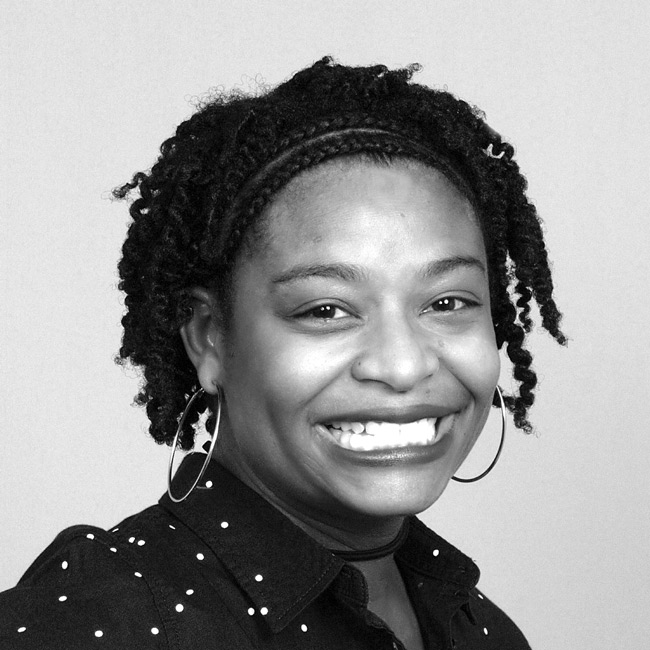
What in the article resonated most for you?
Every time a Black designer gets a good creative job, his presence and talent serves to open the field further for other Blacks — provided the established designer is willing to share his experience with talented but uninformed Black youth, as well as with Black designers on their way up (as we have seen, this willingness to share is not always forthcoming).
This quote resonates with me deeply. While there are countless examples of Black designers being denied opportunity by predominantly White institutions, we don’t often discuss the ways Black designers uphold White supremacist behavior or become gatekeepers once they do make it to the top. I think there is a powerful opportunity when one achieves that level of access or status, that they are able to become mentors or advocates for emerging Black designers. Being willing to check your ego at the door is necessary when you are mentoring someone. I’ve benefited from mentors that have been forthcoming, honest, and direct about their experiences, and I value the guidance they provided when I was uncertain about the field. The role we play in someone’s growth can have a lasting impact, and one that can directly influence whether one decides to stay in this field or choose a different industry altogether.
While there are countless examples of Black designers being denied opportunity by predominantly White institutions, we don’t often discuss the ways Black designers uphold White supremacist behavior or become gatekeepers once they do make it to the top.
What has changed?
I think one of the major aspects that has changed is an understanding of what “graphic design” means in today’s context. At the time that Dorothy’s article was published, advertising and commercial design seemed to be the major focus of where Black designers were headed. As the field fragments into multiple sub-disciplines, new pathways are expanding a Black designer’s opportunities. This is exciting, because it means we are able to pick and choose from a wider array of design disciplines. Today, there are design researchers, design thought leaders, design academics, design practitioners (digital or print), design activists, design historians. We need Black designers in all of these areas. Design practice is more expansive than ever before, and it is critical that we have a variety of Black designers that are making, writing, documenting, and archiving the work of Black designers to expand our historical canon. To me, that is what’s most exciting right now — seeing the canon expand to include multiple histories even while the canon itself is questioned by design educators and practitioners.
New pathways are expanding a Black designer’s opportunities. Today, there are design researchers, design thought leaders, design academics, design practitioners (digital or print), design activists, design historians. We need Black designers in all of these areas.
What remains the same?
Dorothy describes many of the issues Black designers still face today, from being tokenized, encountering differences in pay (racial and gender inequities), and disparities in design education, to proximity to industry contacts and networks. Alex Walker:
Unusually long periods of employment at one job tend to hamper one’s creative processes. Most white designers who eventually become award-winning art directors or make lots of money spent short periods of time in various studios and agencies. With each move, their knowledge, contacts, and usually their incomes increased. This is one modus operandi that has left the Black designer in the dust…
I was considering how this could apply in today’s context. While I agree that having exposure to different facets of the industry can give you a greater range of expertise and value, I believe there are a number of factors (student loans, rent, utilities, health insurance, etc.) that keep Black designers employed in one job for a long time. One of the biggest challenges is the difficulty that comes when leaving a stable job. The disruption to one’s financial or emotional stability is a huge risk. I think this is something that has remained the same in some ways. It is uncertain how a new environment is going to be, how welcoming a new design studio is going to be, and whether you make less money overall.
Do you see signs of future change?
I am hopeful for design programs that begin to merge larger critical discussions around race and racism into the classroom. In my own classes, I am invested in interrogating the ways of making that contribute to perpetuating systems of oppression. This can’t, nor should it, fall solely on Black design educators; the next generation of design educators should constantly be questioning what work is of importance and expanding the design canon. New teaching methods are folding in discussions around race, design, and equity. The future of design education is dependent on educators who understand the vital nature of sharing ideas, histories, and beliefs of BIPOC people. Alongside this, we need Black designers who are willing to share their path of success, and become mentors when they arrive in change-making positions.
Kaleena Sales

What in the article resonated most for you?
The idea that we have to deny our Blackness to operate successfully in the design world is something that really resonated with me. I’ve written about my experiences, and the experiences of my students (mostly Black, attending an HBCU) feeling pressure to accommodate White culture in order to be successful. Those accommodations are sometimes made in the way we physically present ourselves (always being conscious of how we are being perceived), as well as in the design choices we make (designing to please Eurocentric standards).
What has changed?
I think that there’s better understanding now of the ways in which systems have worked against the advancement of Black people as a whole, including in the design industry. So, I would say that we see with a wider lens now that the responsibility of elevating Black designers doesn’t have to fall on the shoulders of other Black people in the industry. Organizations, agencies, and educational institutions that have the power to change systemic issues are really beginning to be held accountable for their contribution in this area.
I think it’s still very difficult to find design professionals who look like me.
What remains the same?
I think it’s still very difficult to find design professionals who look like me. Before teaching, when I worked as an art director and designer, I’d never worked alongside another Black, female designer (outside of volunteer activities). When my students visit design studios and agencies, I’ve rarely seen more than one to three Black designers.
I’ve seen substantial moves toward creating more inclusive learning materials, with efforts to de-centralize European influences
Do you see signs of future change?
I think people are finally listening with the intent to learn. I’ve personally engaged in lots of meaningful dialogue recently and participated on some panel discussions with industry leaders who seem to genuinely want to make positive change. As an educator, I’ve seen substantial moves toward creating more inclusive learning materials, with efforts to de-centralize European influences (International Typographic Style, Bauhaus, etc.) and include more focus on underrepresented cultural groups. These shifts in design education will undoubtedly impact the attitudes of the next generation of designers in positive ways.
Maurice Cherry
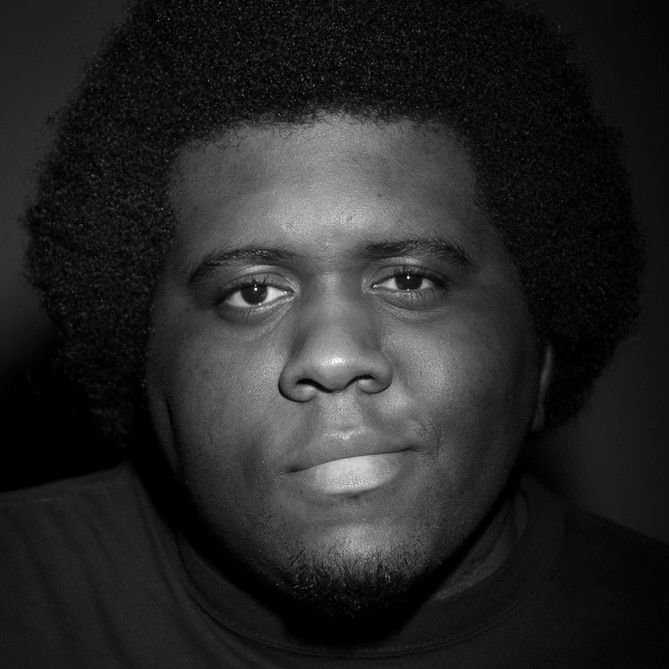
What in the article resonated most for you?
Near the end of Dorothy’s piece, she says that their chances for achieving a career in this field are considerably better than they were a few years ago (in the mid 1960s). It’s heartening to know that the push for change in this industry has been going on for at least 50 years, but then again, here we are in 2020 talking about the issue because it’s still present! That is wild to me.
What has changed?
Technology has created new entry points for Black designers to gain experience in this industry outside the path of attending art school. This helps with bypassing negative experiences from design educators and grossly Eurocentric curricula at top design schools that could dissuade Black designers from continuing. However, because design and technology these days are so intertwined, that has led to dozens of different disciplines of design which didn’t exist a decade ago (let alone during the time of Dorothy’s article). There’s more that you can do with design knowledge now, and that’s changing at a rapid pace.
What remains the same?
Early on in the article, there’s a description about how Black designers encounter embarrassing and humiliating situations while just trying to find work. It seems this is a shared experience, whether you’re self-taught or you go to one of the top art schools in the country. I can tell you this from the hundreds of designers I’ve interviewed over the years, as well as from personal experience. I started my studio in 2008 largely because finding work was so difficult; and even when I ran my studio, I would generally end up with the same leads that William Wacasey described in the article: “the smaller jobs or those with practically no budget”. Even worse, when I did start looking for full-time employment in 2017, the work that I did with my studio ended up being dismissed and overlooked by companies and recruiters, because I wasn’t working for an agency or a larger company. You’re damned if you do, and you’re damned if you don’t.
It’s going to be up to White agency owners and design educators and tech CEOs to cede their power, positions, and pocketbooks to make change happen.
Do you see signs of future change?
That’s a good question, but you’re asking the wrong person. Ask the White agency owners and design educators and tech CEOs if they see signs of future change, because it’s going to be up to them to cede their power, positions, and pocketbooks to make this happen. Black designers have showed up and showed out in each facet of the design industry in the midst of everything mentioned in this article for decades. The amount of excellence we have achieved in spite of this adversity has given us a superpower that is undeniable. And yet, we still encounter these same roadblocks mentioned in this article and more. It’s chilling how much of what Dorothy wrote about over 50 years ago still rings true today.
Maurice Woods
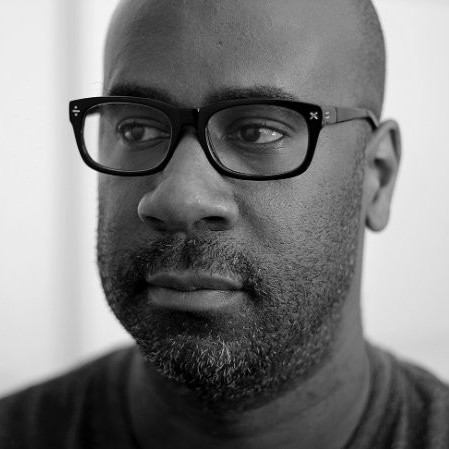
What in the article resonated most for you?
For me, a lot of what is being said here I can relate to. What resonates the most is the importance of Black design leaders’ involvement in supporting young designers or those coming up in the industry. I’ve benefited from having a Black design mentor, Tony Gable, who had his own design business and worked on projects that I related to. This helped me tremendously. I can say that without his presence early in my college years, I might not be where I am today.
Another point that this article brings to bear is the broader context around Black representation in creative fields as a foundation for design to properly serve humanity. Having Black people represented goes a long way towards creating an equitable future where visual and spoken narratives push for a positive view of Black lives in the eyes of American culture.
Black representation in creative fields can be a foundation for how design serves humanity.
What has changed?
For design: Consumers have come to appreciate, and therefore expect “good” design.
This is not just the visual, but the total experience as well. Design can’t just be about communicating an idea; it must captivate, entertain, or provide real solutions to problems to be worth consuming or paying for. Technology has also changed the way we design things, too. There are many more channels from which consumers can ingest content, which brings a new level of opportunities and challenges for designers to solve. Last, the consumer has a louder voice. People can voice their collective disappointment and that can result in changing how a product or service is designed or business is done.
For Blacks: Black purchasing power has increased from $4.32 billion in 1968 to roughly $1.3 trillion as of 2018 — an increase of almost 300x! As Blacks spend more they are also looking at the companies they support. The design community’s responsibility in addressing the Black market is critical not only when it comes to hiring designers of color, but when it comes to understanding the needs and wants of the “new majority” market that is inevitably growing in America.
What remains the same?
The institution of inclusion and inequality has not changed much. Mostly because the institutions for which the industry was built have been dominated by White males. The culture (most leadership is White), policies, and barriers to entry mostly support Whites. Big companies generally look for designers from top design schools, while national stats show that Blacks are not going to the “top tier” schools, but rather to smaller colleges that don’t have the resources elite schools have.
There is, of course, racism that exists in the workplace, but for the most part, I have found that non-Black and Brown folks I know do care about equality and inclusion. But they either don’t know what to do or don’t feel it is their responsibility to spend the kind of resources toward making the industry more equitable for all people.
Seeing signs of change can be deceptive if we don’t trace the roots of power.
Do you see signs of future change?
To clarify, the “broader awareness” has simply woken White America up to what Black
and Brown people have experienced for years. As a Black man in the design industry for over 20 years, racism is often a nuanced comment made, a way of behaving around people, or dealing with the “cost of doing business”. As we look at the tides of race and the “new majority” in this country, I see some potential for change which may eventually force corporations to change — this would have a rippling effect on the design industry. If you look at the marches and support for Black Lives Matter, this also gives me hope that we might be able to stand together, across races, to affect systemic changes. However, the road is long, and the power imbalance is still rooted deep within the hands of Whites. Even though Black buying power has rapidly increased over the years, they are small in comparison to White buying power in this country, which is almost 800% more than the highest minority buying group, Hispanic. My point is, seeing signs of change can be deceptive if we don’t trace the roots of power. Those with the money control the industry. It’s like trying to win a 400-meter race when one of the contestants has a 300-meter head start — we may finish our race with a better speed, but it will be hard to compete unless we close the advantage gap.
To combat racism in the industry, we should be looking at the entire life cycles of Black and Brown people.
I see and appreciate the efforts some people and companies are making to bring more Black and Brown designers to their company, but a shift in our industry goes beyond increasing diversity; it also goes beyond admitting that there is a problem. To combat racism in the industry, we should be looking at the entire life cycles of Black and Brown people — specifically the effects of many years of social, economic, and psychological oppression; discriminatory laws and policies; under-funded education programs; and lack of opportunities. These are systemic barriers that affect one’s ability to develop critical and creative skills and get the right exposure to take advantage of a career opportunity.
Michele Y. Washington
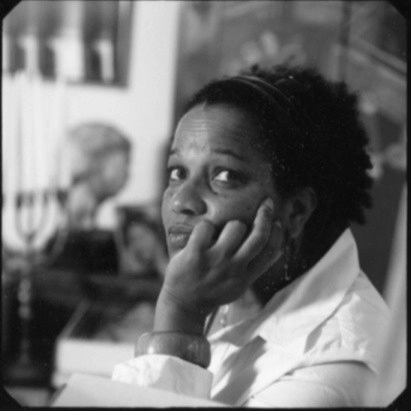
I’m elated to be amongst a stellar group of designers responding to this article. Some are longtime friends I’ve met along my journey; others are familiar names whose work I’ve followed; and a few are new to me. I’m proud be included with these visionaries.
Reading the article brought to mind a recent interview between author Jason Reynolds and Krista Tippet, host of On Being. Jason shared a proverb from Senegal, “When an elder dies, a library burns down.” For me, this saying resonates with my mission and passion for preserving our history as Black designers in the canons of not just design history, but American history in general.
“When an elder dies, a library burns down.” This Sengalese proverb resonates with my passion for preserving our history as Black designers.
For years, I would hear from young students, “I didn’t know these designers were Black!” Or, students would question whether there were any Black designers who made major contributions to design, as was the case with Tracey Sewell who was told by her professor to not interview me at the Design Educators conference where I was presenting, because “Black designers had not made any major contributions to the field of design”. These interactions sent me on a path of furthering my research, lecturing, and exhibition curation. I’m also working on digitizing my old taped interviews of Black designers, including John Morning, Georg Olden’s conversation at the Art Directors Club, Reynold Ruffins, and Dorothy Hayes, who is featured in this 1968 article. Other taped interviews include Cheryl D. Miller, Sylvia Harris, Tom Wirth talking about Richard Bruce Nugent, and art historian Leslie King-Hammond. One person I interviewed told a story very similar to Bill Howell’s. He said he could get work, but he’d have to go in later in the day and the work would be handed to him so the client would never know he was Black.
Today, the visibility of Black designers is hampered by the lack of attention paid to graduates of Historically Black Colleges and Universities (HBCUs). These designers are often unseen by the profession. They may not be members of the AIGA, and thus not part of their census, and not part of the conversation.
The visibility of Black designers is hampered by the lack of attention paid to graduates of HBCUs.
In considering Black participation it’s also important to remember that attending conferences is costly. This is why the Organization of Black Designers (OBD) was formed in 1990. Their conference, initially organized by David Rice, Fo Wilson, Sylvia Harris, myself, and others, brings together people who work in all areas of design — not just graphic design, but product design, interior design, fashion, and architecture. Harvard’s “Black In Design” conference offers similar opportunities. This networking between disciplines in an environment dedicated to Black designers is an important way for them to be part of a broader professional community.
Before our three pandemics, several art/design schools across the country have begun restructuring their programs across disciplines. Some of these include: Arizona State University, Columbia College, OCAD, and Ramon Tejada at RISD. In 2011, Coco Fusco and Yvonne Watson organized Black Studies in Art and Design Education, calling for Black studies offerings throughout Parsons at The New School. At the conference, Fusco had this to say, which is relevant today with restructuring design programs:
The artists, designers, and scholars we have brought together for this conference share a commitment to finding ways of making Black Studies part of every student’s education. Parsons is uniquely poised to address these matters, due to its location in a university with a longstanding commitment to social justice and in a city with one of the largest urban Black populations in the country.
Right now, I’m privy to several letters sent by black students and faculty from major institutions, all demanding changes. These letters have brought me tears, and made me proud of those who stand up and take a bold stance demanding systemic changes from the top down, to faculty, curriculum, research, and more.
We need to introduce our work to more archives, researchers, and exhibitions.
We need to reexamine professional organizations that, in many ways, are still holding onto the past. We need to offer more ways to mentor our Black and Brown students during school and after they graduate. And we need to introduce our work to more archives, researchers, and exhibitions that travel globally. Examples of this last effort in action:
- The National Museum of African American History and Culture accepts digitized design work.
- Cooper Hewitt, Smithsonian Design Museum established an African American Design Archive about 20 years ago (though I don’t know its current state).
- Jerome Harris curated the “As, Not For” exhibition in 2018 and it continues to travel.
- Mabel Wilson, architect and scholar, has developed archives for MoMA and is one of the organizers of “Reconstructions: Architecture and Blackness in America” set for Fall 2020.
- Sekou Jones curated “Close to the Edge; The Birth of Hip Hop Architecture”, held in 2018 at the Center for Architecture in NYC.
- Saki Mafundikwa established the ZIVA Design school in his home country, Zimbabwe. We can surely use his model here in the US.
Ron Tinsley

What in the article resonated most for you?
It confirms that this issue of Black designers being denied opportunities is not new. I am not surprised at all considering that the Voting Rights Act was passed just three years before this article was written. The cold reception received in art school from Black design students is still a common one. I wrote about my experience in my “Open Letter to the White Graphic Design Community”. I could not always figure out if my professors were afraid of me, simply thought I had no talent, or both. What is definitely true is that when you are Black in an unsupportive learning environment, graduate, and enter the professional world, you develop a resilience that can be seen in the Black designers in this article. But, unfortunately, some Black professionals leave the field entirely.
What has changed?
I believe there are more opportunities for Black designers as the field has diversified. Also, with a heavy reliance on affordable technology (computers, software, and the internet), many more can buy the equipment, educate themselves on YouTube, and enter the field. But the results are uneven because every newly created position may not be able to provide a living wage. Without a direct pathway into a focused design career, Black designers diversify their skills. This gives birth to Black Excellence. This means in spite of being denied, Black designers continue to develop themselves and end up with additional skills and abilities.
What remains the same?
Black designers still don’t experience the kind of mentorship that would give them the opportunity to be noticed by premier design firms/agencies and place them in contact with the design elite. Michael Bierut talks about the importance of working for and being mentored by the late Massimo Vignelli. The late Milton Glaser studied under Giorgio Morandi in Italy. Very few Black designers I have met have been mentored professionally by visible, respected designers and artists, because they don’t hire us. Mentorship is important to build knowledge (business, client relations, design, etc.) and provide learning opportunities. Many Black designers have honed their talents by being mentored by professionals outside the design field and/or tapping into the deep wells of African American culture.
Michael Bierut talks about the importance of working for and being mentored by the late Massimo Vignelli. The late Milton Glaser studied under Giorgio Morandi in Italy. Very few Black designers I have met have been mentored professionally by visible, respected designers and artists, because they don’t hire us.
In spite of this resilience, we still remain invisible. It is telling that the AIGA has given posthumous awards to Black designers but cannot seem to figure out where the living Black designers are. This is one of the reasons why Black designers have started their own Facebook groups, such as the African American Graphic Designers and Black Designers United.
Do you see signs of future change?
No. I see White-owned companies making statements about Black Lives Matter, but I question whether they are extending their internal diversity and inclusion policies toward the design firms and marketing agencies they hire. It would be great if industries would follow the model of US cities by demanding a certain percentage of minority representation from their subcontractors. I also haven’t heard any art schools making any serious commitments to diversity beyond their usual tokenism and “we must do better” platitudes.
It would be great if industries would follow the model of US cities by demanding a certain percentage of minority representation from their subcontractors.
Where I do have hope is when designers like Cheryl Miller share little-known information about Black designers that none of the art schools and design history books talk about. I hope for a future where young Black designers see themselves in design history.
Schessa Garbutt
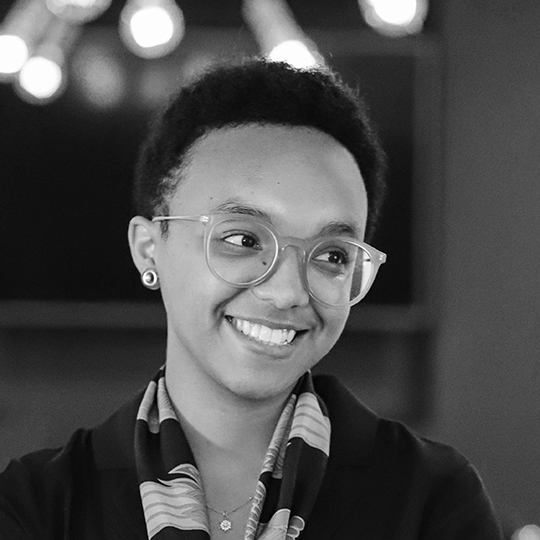
What in the article resonated most for you?
The beginning of the article posits that there are many reasons that there are so few Black designers that have to do with training or discrimination. But it’s also that the narrow way design is defined, and who is lauded as canon, doesn’t allow us to see ourselves; to see that our communities have been using design skills for ages. Working within constraints and small budgets, solving complex problems, and figuring out just how much of ourselves we can bring to work (through clothes, hair, code-switching) are all design skills that don’t get credited as work that we do on top of our jobs. My mother was the first designer I ever knew. But we didn’t call it design; we called it hustling.
My mother was the first designer I ever knew. But we didn’t call it design; we called it hustling.
What has changed?
Well, we’ve got 1% more Black designers in just 40 years! Wooo! … What does seem to have changed (from my experience) is that experienced designers are so ready right now to provide mentorship and resources to emerging Black designers in the industry. Now is a great time to reach out to potential mentors and to start building a rapport (and realize that you don’t need just one perfect mentor to cover everything you’re interested in)!
What remains the same?
We’re still seeing Black designers going out on their own sooner than their White counterparts — whether freelancing or starting their own studios. The shift to working for myself full-time happened in part because I wanted more freedom to explore and define my own aesthetic, getting out from under the biases of “good” design, which are largely founded in the (70-year-old!) Swiss style and ideas of minimalism. I also wanted to cultivate a new work culture for myself — one that wasn’t paternalistic and stifling, but allowed for more free association in my creativity. I’m defining my role on a weekly basis. Rather than being just a designer, my work orbits around several themes (equity and sustainability, participatory design, introspection). I also get to be a writer, illustrator, teacher, and futurist — that freedom is something that appeals to multi-hyphenate Black designers who go out on their own.
I wanted more freedom to explore and define my own aesthetic, getting out from under the biases of “good” design, which are largely founded in the (70-year-old!) Swiss style and ideas of minimalism.
Do you see signs of future change?
The industry has to change. I can’t give you a timeline for when that will be, but I’m seeing young folks in the industry who are so ready for new ways of working — and they didn’t have to be here that long to see that something is deeply wrong with the way we work. Simply hiring more Black designers and bringing them into the existing corporate culture isn’t going to turn our studios into magical utopias. We need a complete system redesign in the ways we experience work and think about creativity. The physical infrastructures (lack of accessibility), policies (racist rules for “professionalism”), and work cultures (toxic productivity) of our agencies and studios remain White/cis-male centered. What would it look like to redesign a work experience and economic system to optimize for a Black+queer+disabled worker? When we focus on seeing and meeting the needs of the most systemically oppressed, all of us will be better off.
Steve A. Jones
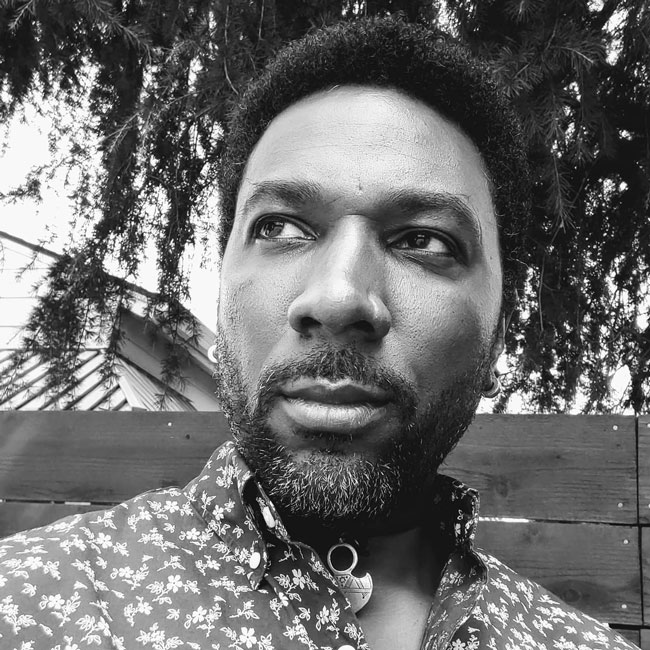
What in the article resonated most for you?
Much of the article resonated with me, but in particular, Dorothy Hayes and Bill Howell spoke about the personal responsibility that many Black designers feel to push for a positive view of Blacks in design — and the conundrum that there are so few of us that it’s difficult to make any meaningful impact. Many Black graphic designers, myself included, feel this way as well. The late designer Sylvia Harris believed that only an increase in the numbers of Black designers doing this type of work could affect real and meaningful change.
What has changed?
Not much at all. The article could be written today and feel pertinent (separate of the technology).
What remains the same?
It’s sad to see how little progress Blacks have made in the graphic design field. In over 50 years the needle has barely moved.
The article addressed issues around the inadequate design education most Black students receive. As a design educator, I’ve observed this many times in the case of Black students with White teachers. White instructors often lack the knowledge, language, history, and cultural understanding to constructively critique and help develop the skills and visual language of their Black students. Oftentimes during student reviews — as a direct result of poor teaching and guidance by their non-Black instructors — the work of these Black students are the least actualized compared to their non-Black classmates.
White instructors often lack the knowledge, language, history, and cultural understanding to constructively critique and help develop the skills and visual language of their Black students.Professionally, issues around tokenism in the workplace and the lack of professional networks/connections still resonate today. The article did touch on the professional Black organization GAP (Group for Advertising Progress). Today there are more organizations and social media groups with similar mission statements.
The advertising industry hasn’t evolved much either. It was interesting to read that advertising in 1968 was “geared almost exclusively to White attitudes and standards, White concepts of beauty, White modes of fashion. Black mannequins and models and flesh-colored skin tones in shades of brown instead of shades of pink are rarely seen in an ad campaign … unless, it is for a predominantly Black market — or when the ad relates to jazz or other ‘Black’ music.”
Do you see signs of future change?
I’m usually a pessimist when the topics of “the future” and “change” come up — so no, not really. Since the murder of George Floyd, I’ve seen countless corporate commercials and advertising from companies that have pledged to fight systemic racism and promise to change their corporate and racial culture going forward. A good friend of mine calls this spectacle the “brandwagon” — when companies slap the BLM logo/philosophy onto their corporate press releases and branding. Design schools have also issued statements in which they promise to dismantle system racism and support their Black students.
If design schools really felt diversity was as important as maintaining and updating their computer labs, there wouldn’t be a problem.
I’ve participated in the graphic design industry and education as they’ve addressed issues of diversity for over 30 years, and every initiative I’ve seen and/or been a part of fell short, or never materialized. I’ve said for a long time that if design schools really felt diversity was as important as maintaining and updating their computer labs, there wouldn’t be a problem.
Anne H. Berry
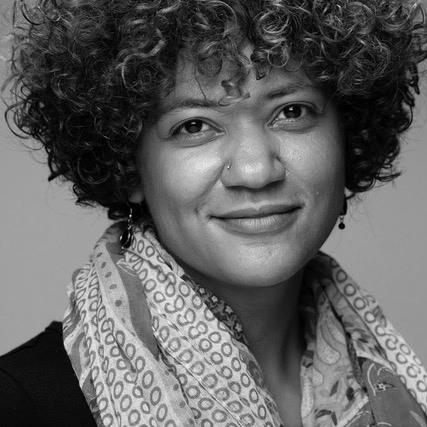
What in the article resonated most for you?
Quite a bit resonated, albeit from the perspective of someone who has benefitted from the efforts of the Black designers who made their way in the world before me. In particular, Dorothy Hayes’s comments that she “couldn’t find anybody Black in the commercial art field” struck me because I’ve had that same experience. Years ago, early in my professional career, I searched online to find more information about other Black designers. I had no idea where to go to connect! (Sad, but very true!) I encountered the same scenario when I moved into design education; it has only been within the last 5–6 years that I developed communities of friends and collaborators that include other Black designers. And, fortunately, these experiences have been incredibly positive. It’s life changing to not only find one another, but to have opportunities to work with and support each other.
Technology has made it easier for people who are interested in design to find a point of entry, even if it’s not through formal education.
What has changed?
I think there are more opportunities for Black designers. And technology has certainly made it easier for people who are interested in design to find a point of entry, even if it’s not through formal education. There are more resources that can be accessed online, for example, and social media has provided avenues for building connections and showcasing work. Additionally, the field of design has expanded into new and interesting areas which, at least in some ways, are less confined or shaped by traditional, European-based standards.
What remains the same?
Lack of mentorship and Black representation is still problematic. Design may no longer be 93% White, as Brenda Mitchell-Powell wrote in her 1991 report, but students aren’t necessarily seeing or learning about the work of Black professionals in the field. Nor are they encountering Black design educators along their career trajectory. (Along with many of my friends and collaborators who teach in higher ed, I am the only Black design faculty member in my program.) Thankfully, we have leaders like Maurice Cherry whose podcast Revision Path is a vehicle for mainstreaming the contributions and creativity of Black designers. It’s not clear, however, if Black design students are getting the support they need.
Students aren’t necessarily seeing or learning about the work of Black professionals in the field. Nor are they encountering Black design educators along their career trajectory.
Do you see signs of future change?
I am cautiously optimistic. There have, seemingly, been a lot of cultural, societal, and political shifts in a relatively short period. So, while the United States as a whole, and design specifically, have made strides, time will tell whether the commitment to systemic change takes root and stands the test of time. We must all be in it for the long haul.
Update
July 15, 2021 — We revisited this feature by publishing an interview with Dr. Elizabeth (Dori) Tunstall, design anthropologist, researcher, educator, and dean of the faculty of designat Ontario College of Art and Design University (OCAD U) in Toronto.
“The Black Experience in Graphic Design: 1986 and 2020” was coproduced with Print, which was recently revived online under new ownership. Stay tuned to printmag.com for the final installment of Cheryl D. Miller’s “Black Designers: Missing In Action” series, which began in 1987.
More about the Black Experience in Graphic Design
- Cheryl D. Miller, “Transcending the Problems of the Black Graphic Designer to Success in the Marketplace”, Pratt Institute, 1985
- Cheryl D. Miller, “Black Designers: Missing in Action”, Print, 1987
- Brenda Mitchell-Powell, “Why is Graphic Design 93% White?”, AIGA, 1991
- Sylvia Harris, “What is it: searching for a black aesthetic in American graphic design” , 1996
- “African-American Designers: The Chicago Experience Then and Now: A Conversation with Pioneers”, Chicago, 2000
- Maurice Cherry, “Where Are the Black Designers?”, 2005
- Maurice Woods, “Envisioning Blackness in American Graphic Design” (a series republished on Medium in 2017–2020), 2006
- Maurice Cherry, Revision Path podcast (weekly interviews with Black designers, developers, and digital creatives), 2013–
- Cheryl D. Holmes-Miller, “Black Designers: Still Missing in Action?”, Print, 2016
- “Diversity & Inclusion Hiring Survey Results”, AIGA Chicago, 2017
- Michele Washington, “Why Black in Design Matters: Learnings from the Harvard conference”, 2019
- Anne H. Berry, “The Black Designer’s Identity”, Recognize Vol. 1, 2019
- “Where Are the Black Designers?” conference site and video recording, 2020
Black Designers at Letterform Archive
- Emory Douglas & The Black Panther
- Amos Paul Kennedy, Jr.
- Amos Paul Kennedy, Jr.: Citizen Printer
- Amos Paul Kennedy, Jr. in Online Archive
- Laini (Sylvia Abernathy)
- Hunter Saxony III
- Joshua Darden
- Chip Thomas
- Abdoulaye and Ibrahima Barry, “Inventing the Adlam Script”
- Silas Munro, “W.E.B. Du Bois’s Data Portraits: Visualizing Black America”
- Saki Mafundikwa, “A Typophile’s Twenty-Year Adventures in Zimbabwe”
